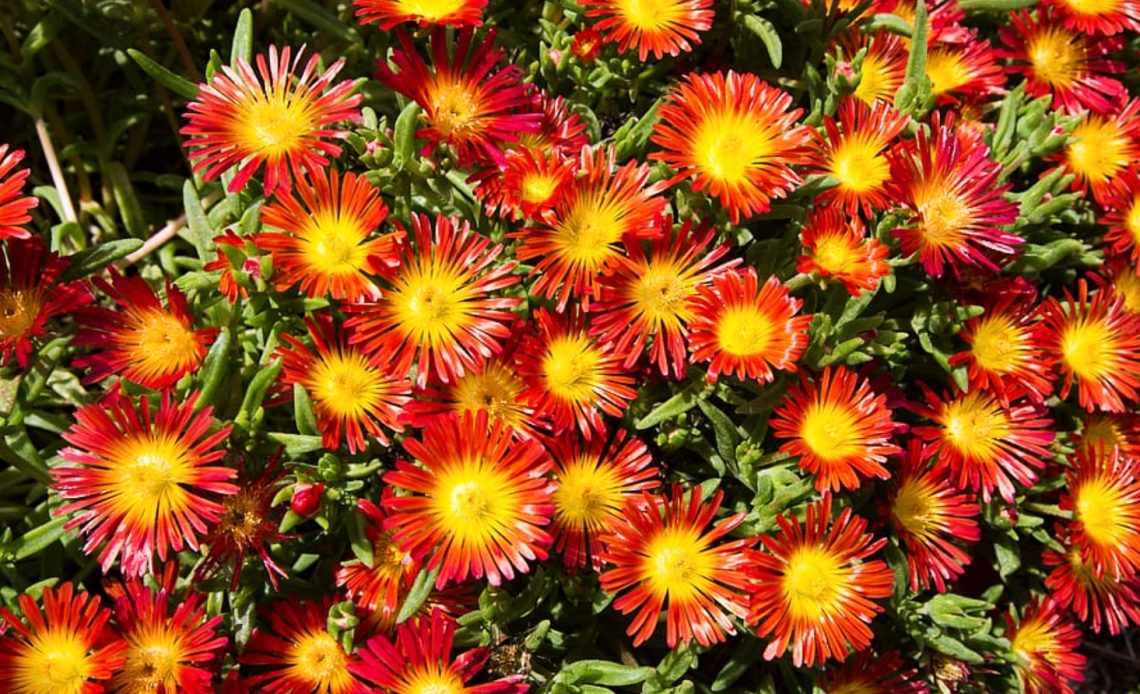

We’re here to help! Wild Yards is a completely free website that is 100% dedicated to helping you create a wildlife-friendly, sustainable yard. Read more
WildYards is reader-supported. When you buy a product through a link on our site, we may earn a comission. Every product is independently selected by our (obsessive) editors and our reviews are unbiased and objective. Read more about our mission or our privacy policy.
If all of the plants in your flower beds have the same size and shape, you’re basically just left with a hedge.
Not that there’s anything wrong with a hedge. They’re great for privacy. But they’re not exactly an all-purpose landscaping feature.
Your flower beds and other areas of your garden need depth and texture. And one of the ways you can achieve this level of dimension is by growing plants of various sizes within the same space.
You’ve got your flower beds filled with shrubs and ornamental grasses, but they need something else to make them stand out.
Define your walkways, edges, and flower beds with the help of these low-growing perennials.
Tickseed, purple coneflowers, blanket flowers, and dianthus are vibrant, open-faced flowers that add color to your garden. Dwarf lantana, ‘Bandera’ lavender, and rose vervain attract countless pollinators to your space.
Creeping Phlox
| Scientific name | Phlox subulata |
| Growing zones | 3 through 9 |
| Maximum size | 6” to 12” tall by 9” to 18” wide |
| Light requirements | Full to partial sunlight |
| Soil preference | Sandy to loamy, fertile and well-draining |
| Soil pH | 6.5 to 7.0 |
| Moisture requirements | Moderate |
| Growth rate | Moderate |
If you want low-maintenance, creeping phlox should be your go-to ground cover.
This flowering, short, and compact perennial produces delicate star-shaped flowers in shades of white, pink, and purple.
Caring for creeping phlox couldn’t be easier. Plants can be pruned in late spring after the first round of flowers to encourage the plants to bloom more.
You can feed your creeping phlox in the early spring with a balanced NPK fertilizer to encourage healthy growth, too. Miracle-Gro Bloom Booster works especially well.
While there’s no need to fertilize your creeping phlox, your local pollinators will thank you for giving the plants some extra food.
Bees and butterflies just love visiting creeping phlox’s scads of flowers. Using this perennial ground cover as a border for your walkways and flower beds is a great way to attract their attention.
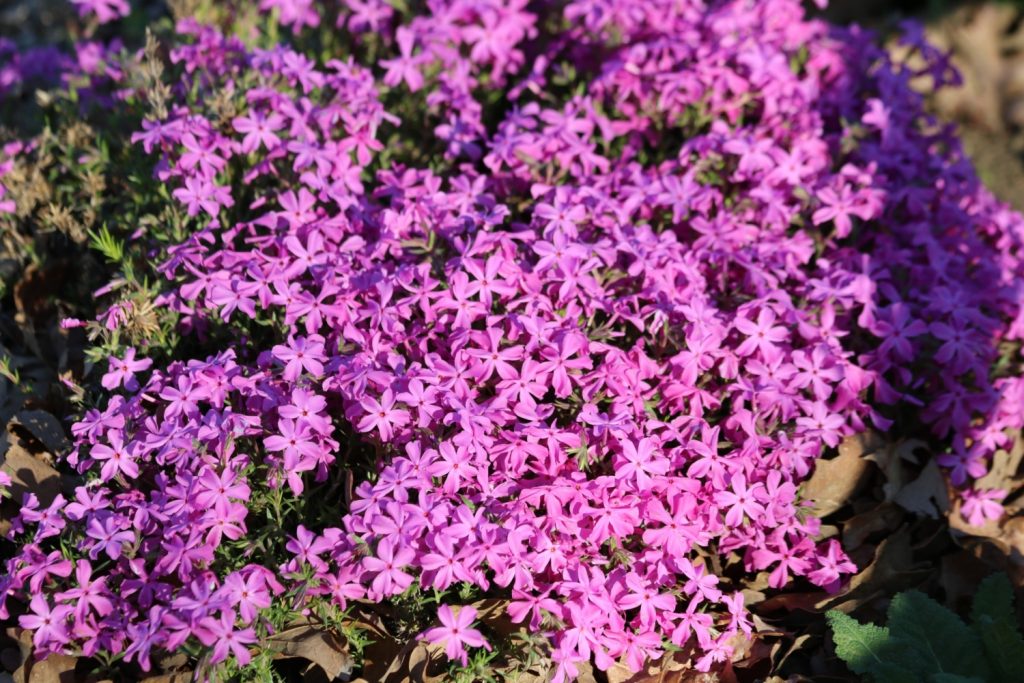
Rose Vervain
| Scientific name | Verbena canadensis |
| Growing zones | 4 through 8 |
| Maximum size | 6” to 18” tall by 12” to 24” wide |
| Light requirements | Full sun, light shade in hot climates |
| Soil preference | Well-draining sandy to loamy soils |
| Soil pH | 6.0 to 7.0 |
| Moisture requirements | Low, drought-tolerant |
| Growth rate | Moderate to fast |
Also called clump verbena, rose vervain is a popular choice for flower boxes thanks to its compact nature. But, when used as an edging for flower beds, this plant creates a lovely, colorful border.
Rose vervain’s stems take root once they touch the ground. New plants can easily be started from cuttings, too, if you decide you want to propagate them.
The plant’s rosie-pink to lavender-purple flowers are a big attraction for butterflies, who are drawn to their rich source of nectar.
These plants are drought-tolerant but should be kept moist when young or newly transplanted until they get established.
Flowers should be deadheaded after plants bloom in spring to encourage more blossoms to develop later on.
Pair the dainty yet hardy rose vervain with petunias, sweet potato vine, or morning glory to create a mixed border for your flower garden.
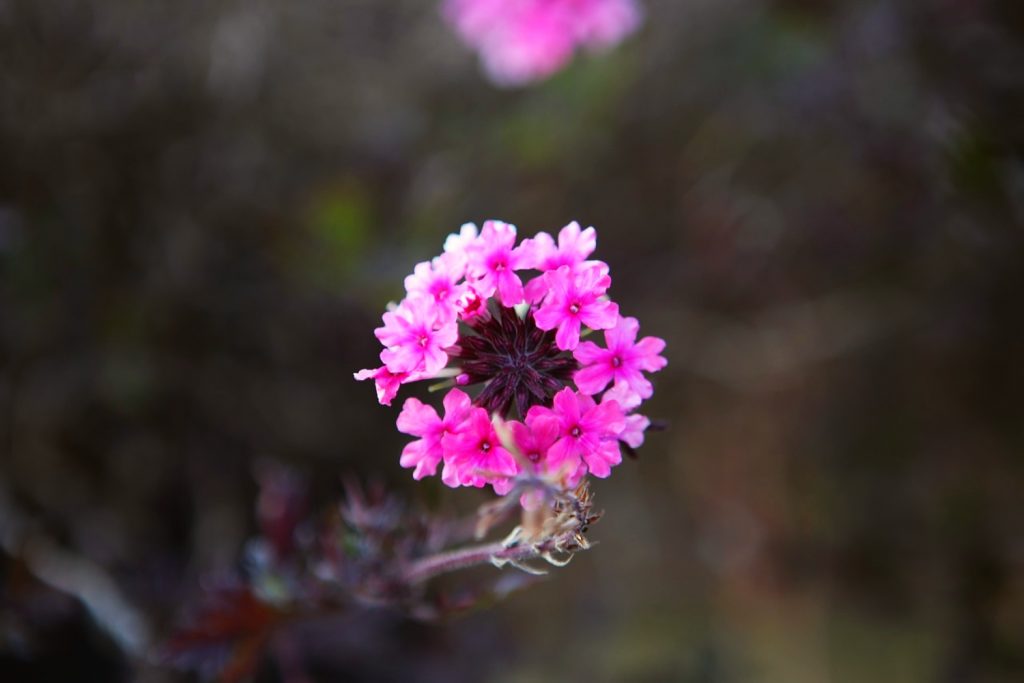
Trailing Ice Plant
| Scientific name | Delosperma cooperi |
| Growing zones | 9 through 11 |
| Maximum size | 6” to 12” tall by 24” to 36” wide |
| Light requirements | Full sun |
| Soil preference | Any soil type, as long as it drains well |
| Soil pH | 6.1 to 7.3 |
| Moisture requirements | Low, drought-tolerant |
| Growth rate | Moderate to fast |
For southwest-style spaces or gardens with a definitive “zen” quality, there’s trailing ice plant. When all of its growing requirements are met, this succulent has the potential to grow rapidly, filling in between pavers and along sidewalks in a jiffy.
Trailing ice plant produces eye-catching magenta flowers with cheery open faces. The flowers pop against the plump needle-like leaves, providing a brilliant contrast and defining your flower beds.
One of the reasons to love trailing ice plant is that it is drought-tolerant. If you want a beautiful garden with low care and water needs, this compact ground cover can help you achieve that goal.
Plants have a trailing nature. When pruned regularly, this encourages shrubby growth.
Keep your trailing ice plant clipped to create a dense carpet of flowers and foliage around your walkways and flower beds.
Dusty Miller
| Scientific name | Jacobaea maritima |
| Growing zones | 8 through 10 |
| Maximum size | 12” to 18” tall by 12” to 24” wide |
| Light requirements | Full to partial sunlight |
| Soil preference | Sandy to loamy well-draining soil |
| Soil pH | 6.0 to 7.5 |
| Moisture requirements | Low, drought-tolerant |
| Growth rate | Fast |
Maybe you’re over flowers. Maybe you want something a little more understated. Something that’s subtle yet sophisticated. Dusty miller fits the bill.
Dusty miller produces silver lace-like foliage that simultaneously attracts attention, yet also fades into the background, making it the perfect “supporting character” for the other plants in your landscaping.
Grown as a border, dusty miller allows you to define a space, yet it does so without detracting from the other plants in the area.
There are so many reasons to love dusty miller, besides the fact that it’s an ideal edging for greenery.
Another great thing about dusty miller is that it’s fast-growing.
These plants can thrive in many different types of soil, including sandy and rocky ones, just as long as they drain well.
One quick note: dusty miller can be prone to powdery mildew, so be sure to keep plants in a well-ventilated area to dissipate humidity.
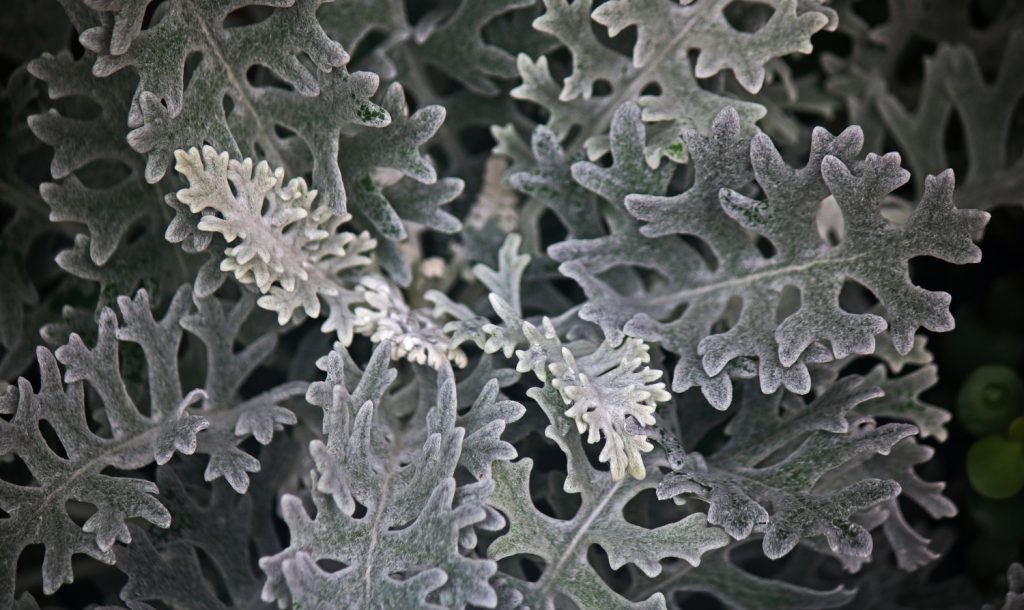
Purple Coneflower
| Scientific name | Echinacea purpurea |
| Growing zones | 3 through 9 |
| Maximum size | 30” to 36” tall by 12” to 18” wide |
| Light requirements | Full sunlight, light shade in hot environments |
| Soil preference | Sandy to loamy, well-draining soil |
| Soil pH | 6.0 to 7.0 |
| Moisture requirements | Low, drought-tolerant |
| Growth rate | Moderate to fast |
Look at just about any pollinator garden layout, and you’re bound to see purple coneflowers.
Planting these beautiful and easy-growing perennials is one of the best things you can do to support your local bees and butterflies.
Purple coneflower, also known as echinacea, is a member of the daisy family, Asteraceae.
Plants have a mounding nature and produce beautiful purple blooms at the tips of large stalks. The flowers themselves are long-lasting and can be harvested to brew a delicious tea.
Echinacea has long been prized for its medicinal benefits. This plant is primarily used to treat symptoms of the common cold — so it’s as useful as it is attractive!
These plants can be used to create a casual border for your flower beds. They can also be grown in a cluster to act as an accent.
Purple coneflowers can help you attract more hummingbirds to your garden. Consider keeping your hummingbird feeders nearby to give them a reason to stick around.
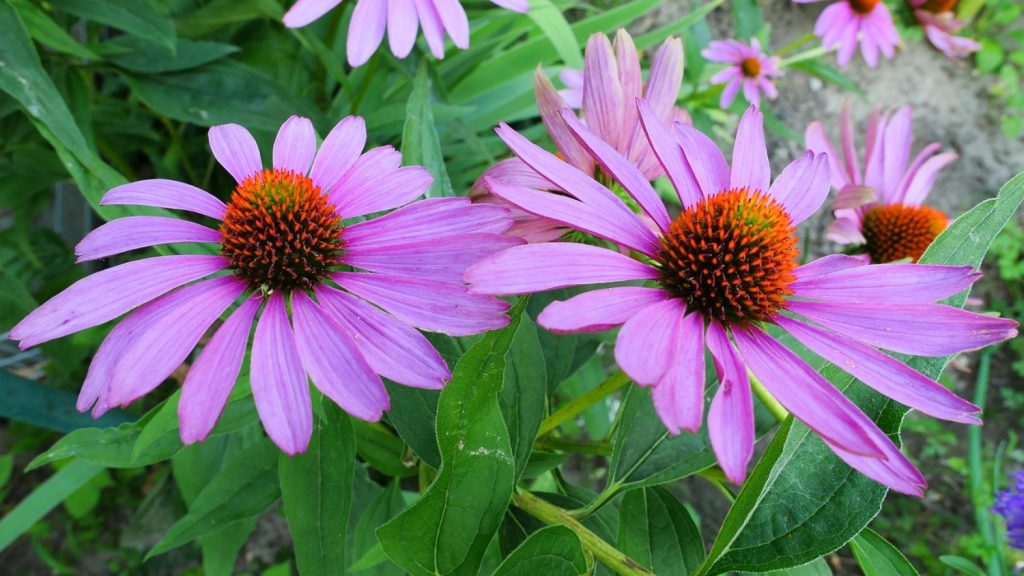
Dwarf Lantana
| Scientific name | Lantana camara |
| Growing zones | 8 through 11 |
| Maximum size | 12” to 24” tall by 18” to 36” wide |
| Light requirements | Full sun, but can tolerate some shade |
| Soil preference | Sandy to loamy, well-draining soil |
| Soil pH | 6.0 to 8.0 |
| Moisture requirements | Moderate, but drought-tolerant once established |
| Growth rate | Moderate to fast |
If you’re a fan of hydrangeas, but your yard gets way too much sunlight to keep them happy, then why not consider lantana, instead?
Dwarf lantana’s dome-shaped flowerheads are like miniaturized hydrangeas, but they come in a wider variety of colors.
You can find dwarf lantana in shades of yellow, orange, pink, red, and white. They’re the perfect choice of edging for flower beds that need a splash of color.
Pollinators can’t get enough of dwarf lantana. The flowers are a great source of pollen and nectar and produce a sweet yet mild fragrance that’s attractive to beneficial insects — and hummingbirds, too!
Dwarf lantanas are moderate to fast-growing. They benefit from annual feedings with compost and/or manure.
This flower’s low-growing compact nature makes it ideal for edging sidewalks, walkways, and pollinator-friendly flower beds.
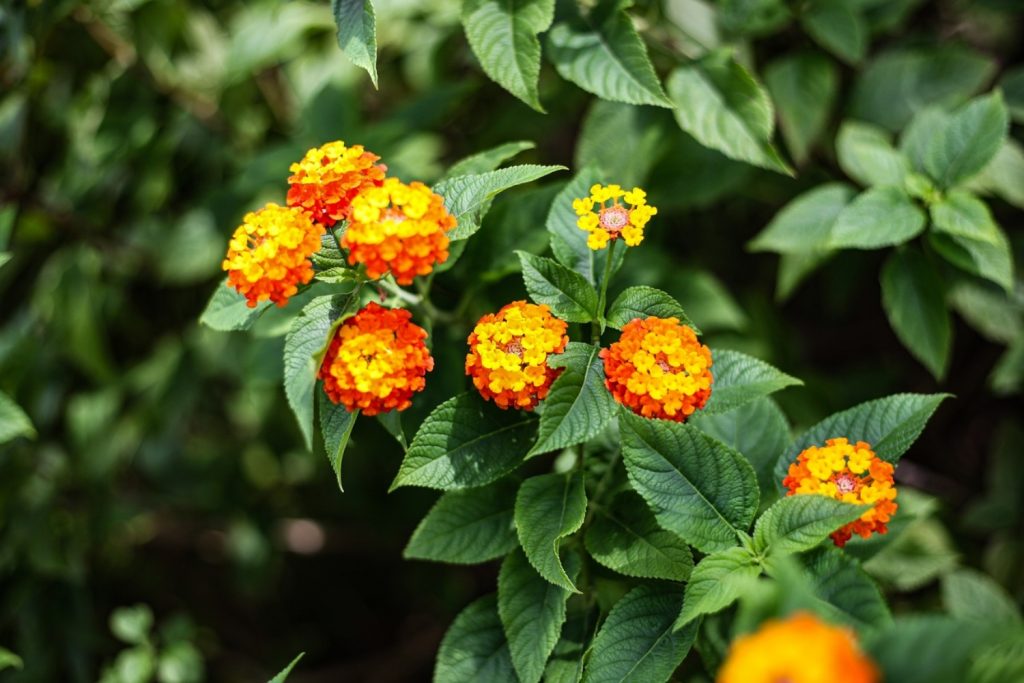
Bishop’s Hat
| Scientific name | Epimedium spp |
| Growing zones | 4 through 9 |
| Maximum size | 12” to 18” tall by 12” to 24” wide |
| Light requirements | Full to partial shade |
| Soil preference | Loamy, fertile, and well-draining |
| Soil pH | 6.1 to 7.8 |
| Moisture requirements | Moderate, drought-tolerant once established |
| Growth rate | Moderate to fast |
Also called barrenwort, bishop’s hat is a ground cover plant that is ideal for shady backyards. This plant can fill in the shadiest spots in your garden without skipping a beat. And it’s drought-tolerant, too!
Bishop’s hat produces dense foliage. Leaves are heart-shaped and elongated, ending in a sharp point. The brown stems contrast with the plant’s elegant forest-green foliage.
Plants bloom in late spring, producing intricate pink-purple flowers that resemble a bishop’s hat (also known as a biretta).
Although tiny, these little flowers can steal the show. When grown as a short hedge for flower beds, or in a cluster in your landscaping, this low-growing perennial will easily capture the attention of passersby.
Bishop’s hat can be grown as an evergreen in warm climates, where its leaves easily survive the winter.
Foliage that has been frost-damaged should be pruned in spring to stimulate new growth and healthy flower production later on in the growing season.
Tickseed
| Scientific name | Coreopsis |
| Growing zones | 4 through 9 |
| Maximum size | 24” to 36” tall by 12” to 24” wide |
| Light requirements | Full to partial sunlight |
| Soil preference | Sandy to loamy soils, fertile and well-draining |
| Soil pH | 5.5 to 6.5 |
| Moisture requirements | Moderate, drought-tolerant once established |
| Growth rate | Moderate to fast |
Also known as pot of gold, tickseed is one hardy little plant that can put up with a wide range of soil types, from sand to clay, from rocky to loamy.
Tickseed produces dense lance-shaped leaves and cheerful-looking open-faced flowers.
They fit right in with dwarf lantana and coneflowers, and your local pollinators will enjoy browsing different types of flowers. In fact, pollinating insects need plant diversity to thrive.
When used as an edging to line paths or flower beds, tickseed fills in nicely, creating a dense thicket of foliage and flowers.
There are so many varieties of tickseed to choose from, but some work better as a border than others.
Look for ‘Rising Sun’ and ‘Golden Showers’, two low-growing yellow cultivars that will line your walkways in gold.
Or choose pink coreopsis and ‘Limerock Ruby’ for a dazzling pink and red display.
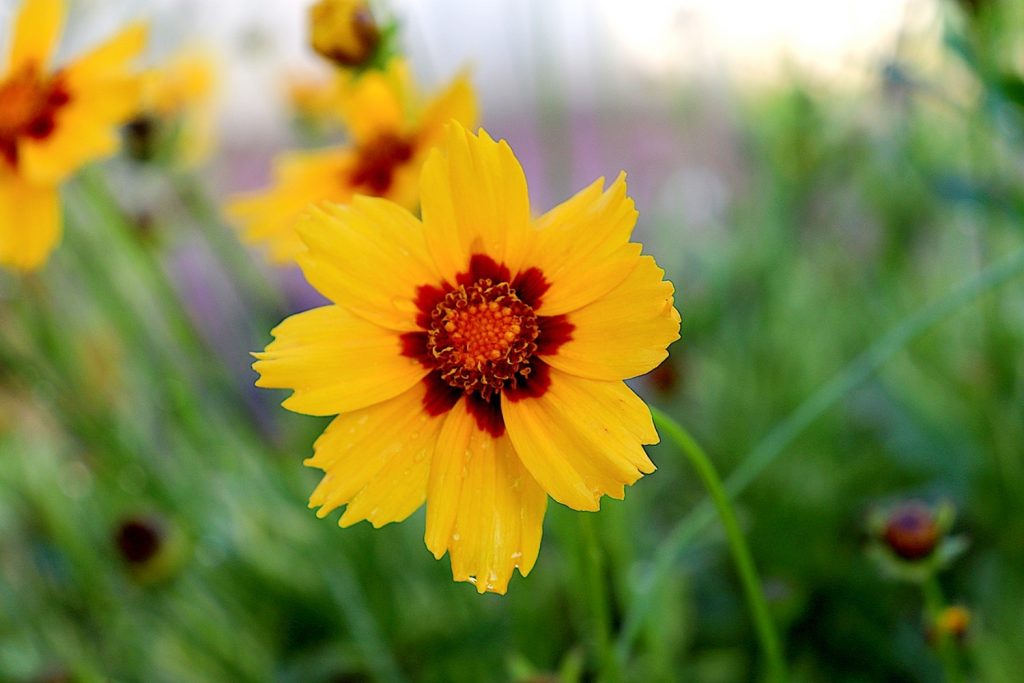
Dianthus
| Scientific name | Dianthus spp |
| Growing zones | 4 through 9 |
| Maximum size | 6” to 18” tall by 6” to 12” wide |
| Light requirements | Full sun, light shade in hot environments |
| Soil preference | Loose, loamy, well-draining soil rich in organic matter |
| Soil pH | 6.0 to 7.5 |
| Moisture requirements | Moderate |
| Growth rate | Moderate |
Dianthus is a classic choice for pots, window boxes, and small flower beds. You just can’t go wrong with these frilly flowers.
Also known as sweet william, dianthus is fairly easy to grow. But it’s essential that you avoid overwatering this short-lived perennial.
Dianthus hate sitting in waterlogged soils. These plants are particularly susceptible to root rot. So be sure to plant them in well-draining soils and avoid leaving the hose on them for too long.
You’ll usually find dianthus in shades of pink, red, and white, but yellow varieties are available, too. Bi-color blooms are also popular.
Plant red or white dianthus along your flower beds for a dramatic effect, or intersperse bi-color dianthus with pink ones to give your garden an informal feel.
Like coneflowers, dianthus is a great choice if you’re trying to attract more butterflies to your backyard.
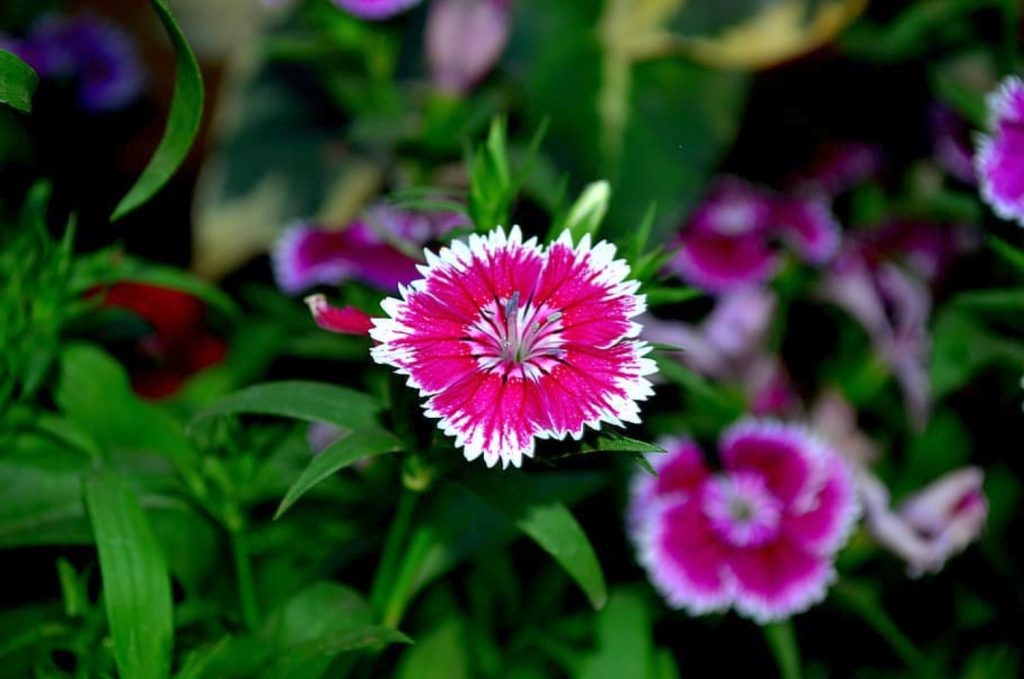
Bandera Purple Lavender
| Scientific name | Lavandula angustifolia ‘Bandera’ |
| Growing zones | 5 through 9 |
| Maximum size | 6” to 10” tall by 10” to 12” wide |
| Light requirements | Full sun |
| Soil preference | Loose, sandy to loamy soil that drains well |
| Soil pH | 6.5 to 7.5 |
| Moisture requirements | Low, drought-tolerant |
| Growth rate | Moderate to fast |
You can use just about any variety of lavender to create a border or even a hedge. But ‘Bandera Purple’ lavender is well-suited to edging flower beds because of its low-growing nature.
Bandera Purple is compact with a mounding habit that allows it to fill in easily and quickly.
Plants bloom from spring to summer and are prolific producers — which is good news for your local honeybees because they love lavender flowers.
One of the great things about this lavender is that it is more forgiving of overwatering than other varieties.
While you should still be sure to plant it in well-draining soil, Bandera Purple is hardy and won’t succumb to root rot as easily as other lavenders.
Bandera Purple is a Spanish lavender, so it’s better suited to warmer growing zones than English or French lavender cultivars.
While Bandera Purple can withstand full sun, the warmer the environment it’s growing in, the more shade it will need.
If your growing zone regularly reaches the 90s and 100s, be sure to give your Bandera Purple some light shade in the afternoons.
Bugleherb
| Scientific name | Ajuga reptans |
| Growing zones | 3 through 9 |
| Maximum size | 6” to 9” tall by 6” to 12” wide |
| Light requirements | Full to partial sun |
| Soil preference | Loamy, well-draining soils that can be kept moist and are rich in organic matter |
| Soil pH | 6.0 to 7.0 |
| Moisture requirements | Low to moderate |
| Growth rate | Fast |
Bugleherb, or bugleweed, or simply “bugle”, is a member of the mint family, Lamiaceae. And, like mint itself, it is considered to be invasive, especially when all of its growing needs are being met.
Of course, that’s not always a bad thing. After all, plants that are considered invasive are often much tougher than others, which means you don’t have to be so attentive to them.
With bugleherb, you can pretty much plant it and forget it.
As long as you give this plant enough sunlight, and plant it in well-draining soil that’s been amended with compost, it can grow lightning-fast.
Bugleherb produces tall purple flowers, similar in appearance to salvia, and are perfect for attracting pollinators.
Using bugleherb as a border for your flower garden will attract hoverflies and predatory wasps, both of which can help keep pest levels down naturally.
Bugle herb is also a preferred source of nectar for a variety of moths and butterflies, including large skippers, common blues, and painted ladies.
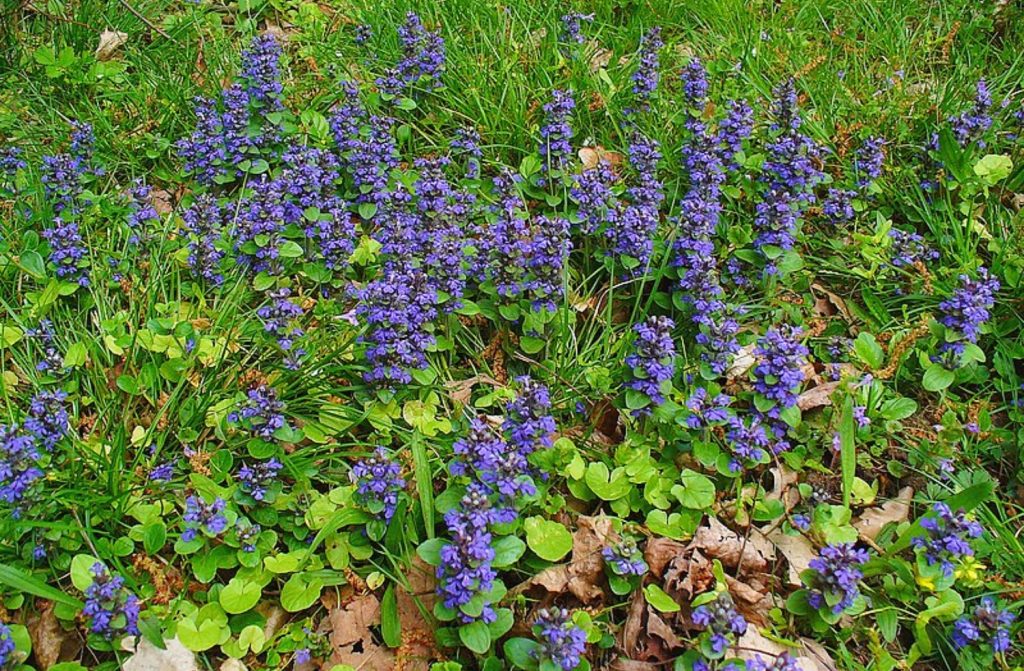
Blanket Flower
| Scientific name | Gaillardia spp |
| Growing zones | 3 through 9 |
| Maximum size | 12” to 36” tall by 12” to 24” wide |
| Light requirements | Full to partial sunlight |
| Soil preference | Sandy to loamy, well-draining |
| Soil pH | 6.0 to 7.0 |
| Moisture requirements | Moderate, drought-tolerant once established |
| Growth rate | Moderate to fast |
If you’ve ever gone on a summer road trip, you’ve probably seen blanket flowers lining the highways.
These gorgeous and easy-growing perennials make the perfect border for low-maintenance, drought-tolerant pollinator gardens.
They’re also an excellent option for rural landscapes, especially if you’re embracing that rustic farmhouse aesthetic.
A relative of the daisy, this member of the Asteraceae family has a bright open face and comes in a rainbow of colors, including yellow, orange, red, brown, purple, and white.
Most blanket flowers are bi-colored.
Blanket flower’s long-lasting blooms will keep your flower garden bright and colorful from spring to summer.
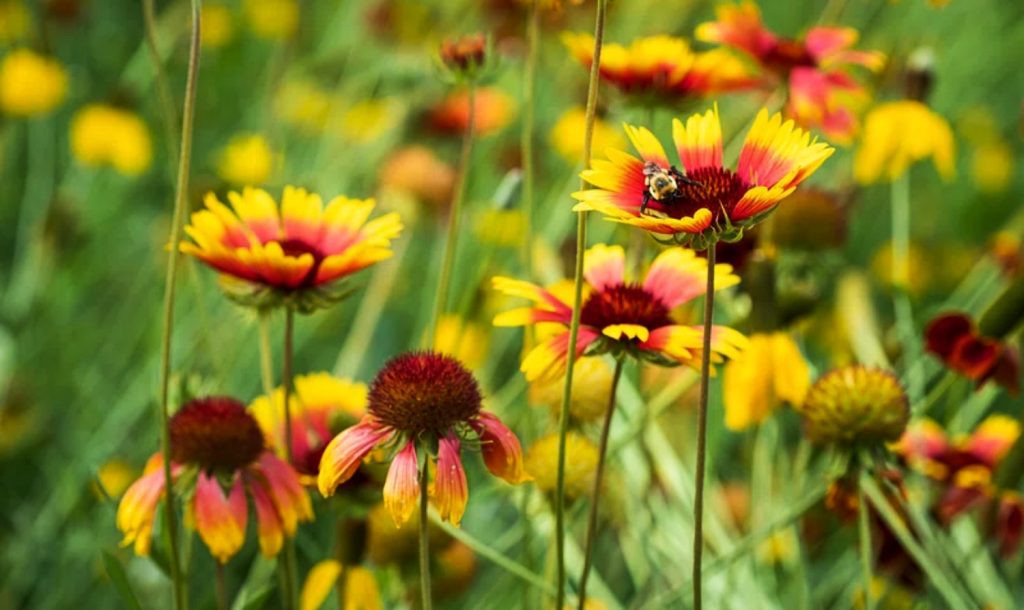
Dwarf Mexican Petunia
| Scientific name | Ruellia brittoniana |
| Growing zones | 8 through 11 |
| Maximum size | 12” tall by 12” wide |
| Light requirements | Full to partial sunlight |
| Soil preference | Loamy, well-draining soil rich in organic matter |
| Soil pH | 5.5 to 7.8 |
| Moisture requirements | Low to moderate |
| Growth rate | Fast |
Plant them in loose, fertile soil, keep them well-watered, and stand back and watch them grow. Dwarf Mexican petunias fill in fast to create a low-growing border for your flower beds.
The plant’s deep green foliage contrasts nicely with its tissue-paper-delicate purple, white, and pink flowers.
Dwarf Mexican petunias work beautifully as a border for irises and lilies because these plants share similar growing requirements.
Dwarf Mexican petunias are especially popular with bees, who love to nestle in the flowers as they collect nectar and pollen.
Use sphagnum moss or peat moss as a mulch around these low-growing perennials to help them retain the moisture they need to flower.
Winecups
| Scientific name | Callirhoe involucrata |
| Growing zones | 4 through 8 |
| Maximum size | 8” to 12” tall by 12 to 36” wide |
| Light requirements | Full to partial sunlight |
| Soil preference | Sandy to loamy, well-draining soil that is moderately fertile |
| Soil pH | 6.0 to 7.0 |
| Moisture requirements | Low, drought-tolerant once established |
| Growth rate |
Sometimes called poppy mallow, winecups are dainty magenta flowers native to the United States.
These plants share similar growing requirements to blanket flowers, and both are often seen growing together in the wild.
Winecups may look delicate. But don’t let their appearance fool you. They can tolerate extreme heat and dry conditions without batting an eye.
Use wine cups to create a border for your rose bushes, or to line the dirt and stone pathways in your garden.
Butterflies and moths just love to visit these flowers. So be sure to include them in your pollinator garden plan.
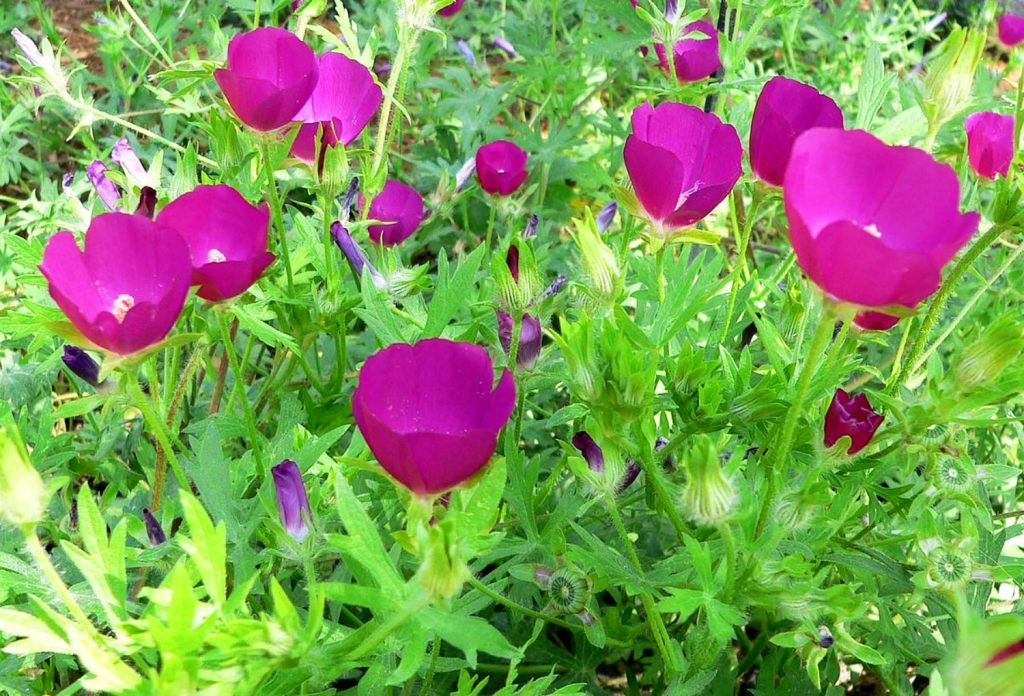
Foamflower
| Scientific name | Tiarella spp |
| Growing zones | 9 through 10 |
| Maximum size | 10” to 12” tall by 12” to 24” wide |
| Light requirements | Full to partial shade |
| Soil preference | Loamy, well-draining soil that’s rich in organic materials |
| Soil pH | 4.5 to 7.0 |
| Moisture requirements | Moderate |
| Growth rate | Slow to moderate |
A shady garden is a blessing in the summertime. But it can be tough finding plants that can survive in such low-light conditions.
Cue foamflower. This woodland native can be found growing wild in the U.S. and produces clusters of frilly white flowers that can last for weeks on end.
Foamflowers are self-sufficient. As long as they’re planted in loose, fertile soil that can be kept slightly moist, they’ll grow just fine.
These plants work well as a border for other shade-tolerant plants, especially greenery like ferns and elephant ears.
Use foamflower to attract beneficial insects to your garden to cool down on a hot day.
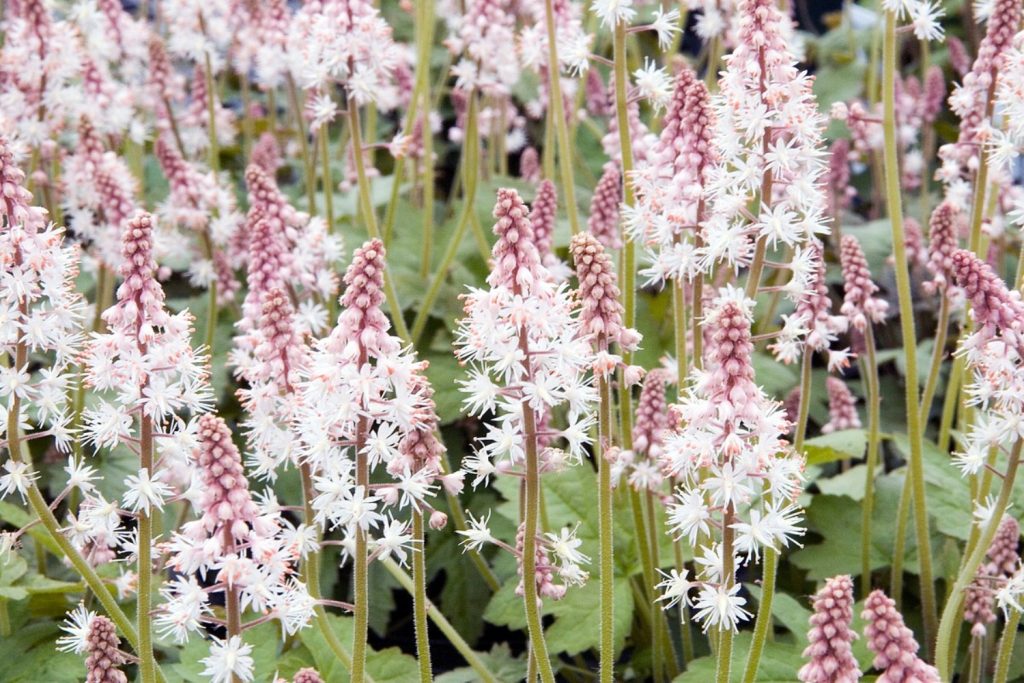
Transform your landscape with low-growing perennials
Landscaping doesn’t have to be a headache. You just have to use your imagination.
Mix and match plants to create an eclectic border for your flower garden. Or choose one plant to surround your landscaped beds for a more manicured appearance.
Either way, with the help of these low-growing perennial plants, you can make the walkways, edges, and flower beds in your landscaping pop!
